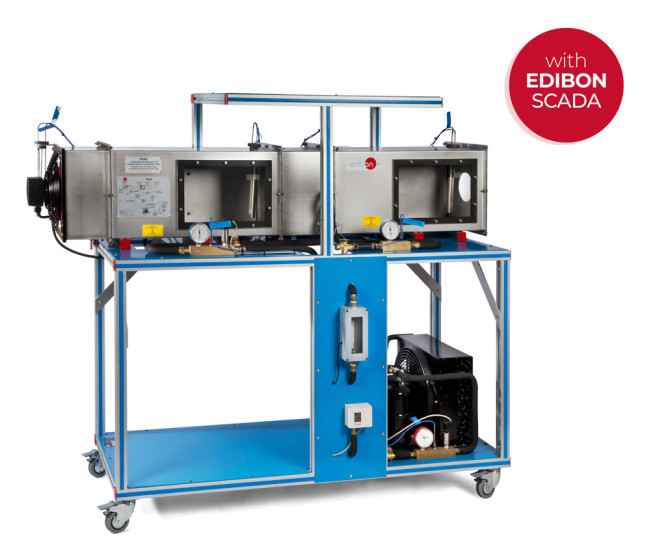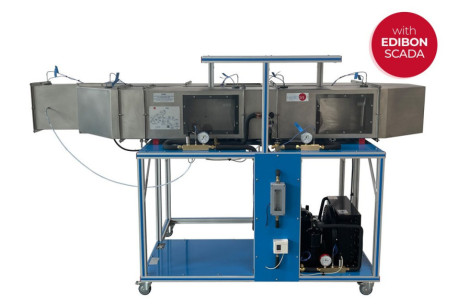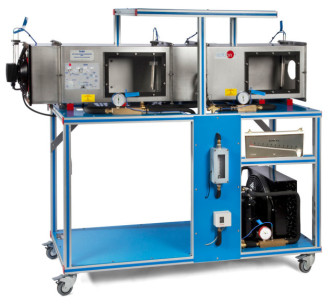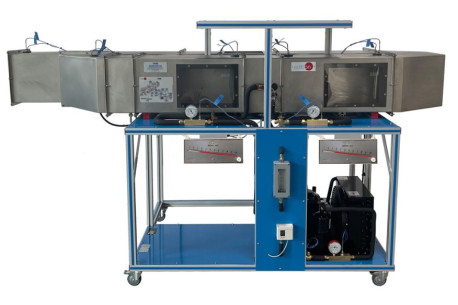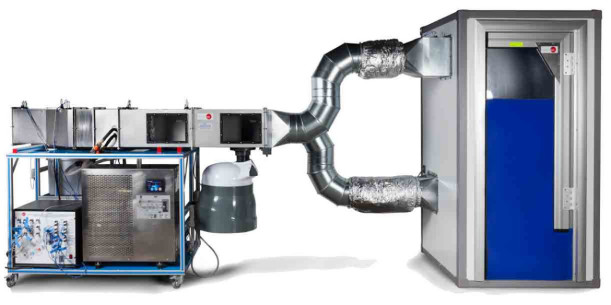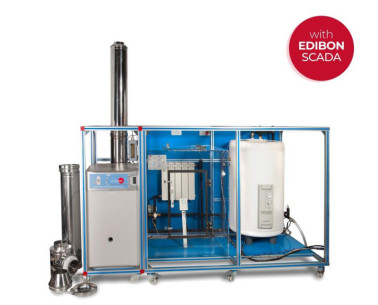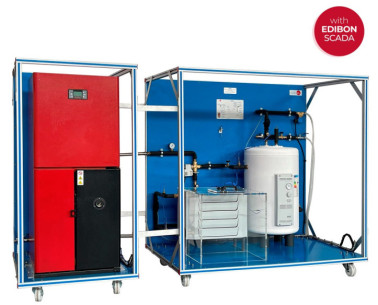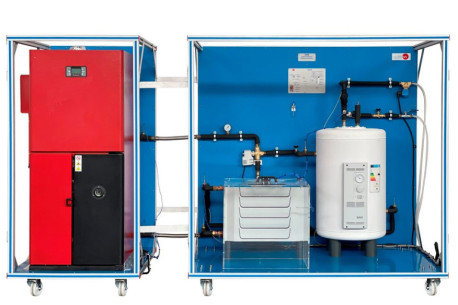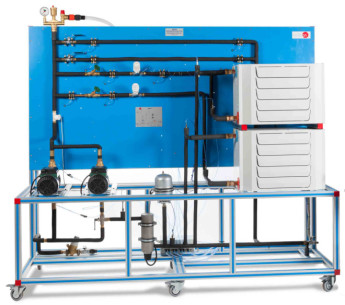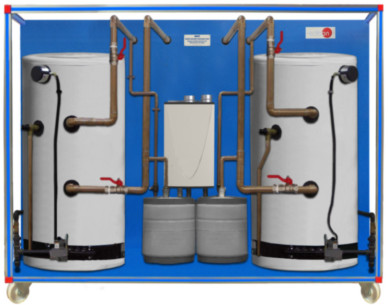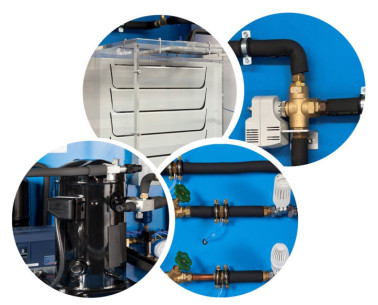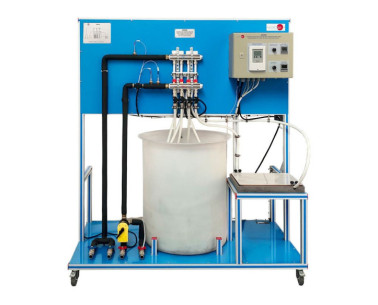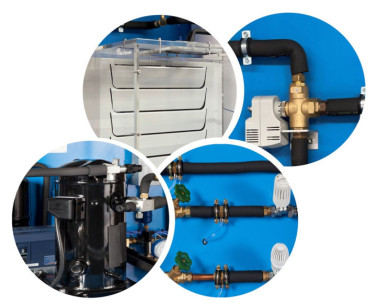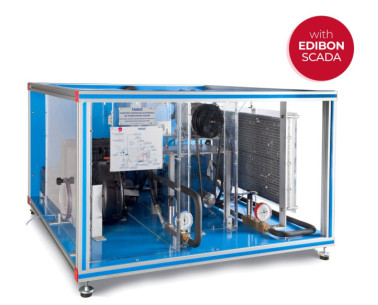TAAC Equipamento de Ar Condicionado de Laboratório, Controlado por Computador (PC)
SISTEMAS INOVADORES
The Computer Controlled Air Conditioning Laboratory Unit, "TAAC", main objective is to introduce the student in the complex world of the air conditioning installations, as well as to study and determine the optimal parameters for the unit operation in function of the environmental requirements (humidity, heat, temperature and refrigeration, etc.).
Expansões
LABORATÓRIOS
NOTÍCIAS RELACIONADAS
Descrição Geral
The Computer Controlled Air Conditioning Laboratory Unit, "TAAC", has been designed to study the change of the air conditions and the refrigeration circuit.
The unit consists of a testing tunnel made of stainless steel, in which there have installed two windows. Inside of the tunnel there is an axial fan (computer controlled) and two heating elements (computer controlled), one situated at the evaporator inlet and other situated at the evaporator outlet.
The unit has a flow sensor and four hygrometers situated along the tunnel. These hygrometers are formed by two temperature sensors (wet and dry bulb).
Two steam lines inject steam from a steam generator (not included) to the tunnel to modify the air characteristics.
The tunnel includes an evaporator in the middle. It consists of a finned radiator through which a coolant flow circulates. This radiator is placed perpendicular to the air flow generated by the fan.
Coolant flows through a closed circuit. It enters to the compressor (computer controlled) and circulates through a filter (to retain particles of condensate), a flow sensor, an expansion valve, the tunnel evaporator (the coolant absorbs the air heat of the flowing through the evaporator) and a condenser.
Several temperature, pressure and flow sensors and manometers have been strategically located, allowing to study the refrigeration cycle and quantify the evaporation and condensation capacity. In addition, the unit includes a high pressure control to avoid an excess of pressure in the unit.
This Computer Controlled Unit is supplied with the EDIBON Computer Control System (SCADA), and includes: The unit itself + a Control Interface Box + a Data Acquisition Board + Computer Control, Data Acquisition and Data Management Software Packages, for controlling the process and all parameters involved in the process.
EXERCÍCIOS E PRÁTICAS GUIADAS
EXERCÍCIOS PRÁTICOS GUIADOS INCLUÍDOS NO MANUAL
- Demonstration of the process and components used in heating, cooling, humidification, dehumidification.
- Obtaining the steam generator efficiency curve.
- Energy balance in the steam generator.
- Efficiency determination of preheating element.
- Preheating effect in an air conditioning installation.
- Dehumidification process study.
- Mass balance in the evaporator.
- Energy balance in the evaporator.
- Re-heat effect.
- Experimental determination of the air specific heating capacity.
- Sensors calibration.
EXERCÍCIOS MAIS PRÁTICOS A SEREM FEITOS COM A UNIDADE
- Psychrometric chart.
- Usage of psychrometric chart.
- Example of the air properties determination.
- Properties of the refrigerant R513a.
- Enthalpy-Pressure diagram for the refrigerant R513a.
Other possibilities to be done with this Unit:
- Many students view results simultaneously. To view all results in real time in the classroom by means of a projector or an electronic whiteboard.
- Open Control, Multicontrol and Real Time Control. This unit allows intrinsically and/or extrinsically to change the span, gains, proportional, integral, derivative parameters, etc, in real time.
- The Computer Control System with SCADA and PID Control allow a real industrial simulation.
- This unit is totally safe as uses mechanical, electrical and electronic, and software safety devices.
- This unit can be used for doing applied research.
- This unit can be used for giving training courses to Industries even to other Technical Education Institutions.
- Control of the TAAC unit process through the control interface box without the computer.
- Visualization of all the sensors values used in the TAAC unit process.
- By using PLC-PI additional 19 more exercises can be done.
- Several other exercises can be done and designed by the user.
EQUIPAMENTOS SIMILARES DISPONÍVEIS
Equipamento de Ar Condicionado de Laboratório
Equipamento de Recirculação de Ar Condicionado
Equipamento de Ar Condicionado com Câmara Climática e Resfriador de Água, Controlado por Computador (PC)
EQUIPAMENTOS COMPLEMENTARES
Equipamento Didático de Produção de Água Quente e Sistema de Aquecimento, Controlado por Computador (PC)
Equipamento de Processo de Biomassa, Controlado por Computador (PC)
Equipamento de Processo de Biomassa
Equipamento de Estudo da Eficiência em um Sistema de Aquecimento, Controlado por Computador (PC)
Equipamento de Treinamento em Aquecedores de Água
Bomba de Calor para Distintas Fontes e Trocadores de Calor
Piso Aquecido e/ou Fonte de Calor para Bomba de Calor
Aquecimento de Ar e/ou Trocador de Ar
Equipamento de Ar Condicionado de Laboratório
Equipamento de Ar Condicionado (Recirculação), Controlado por Computador (PC)
Equipamento de Recirculação de Ar Condicionado
Equipamento de Ar Condicionado de Automóvel, Controlado por Computador (PC)
Qualidade

Serviço pós-venda

 Preferências de cookies
Preferências de cookies

